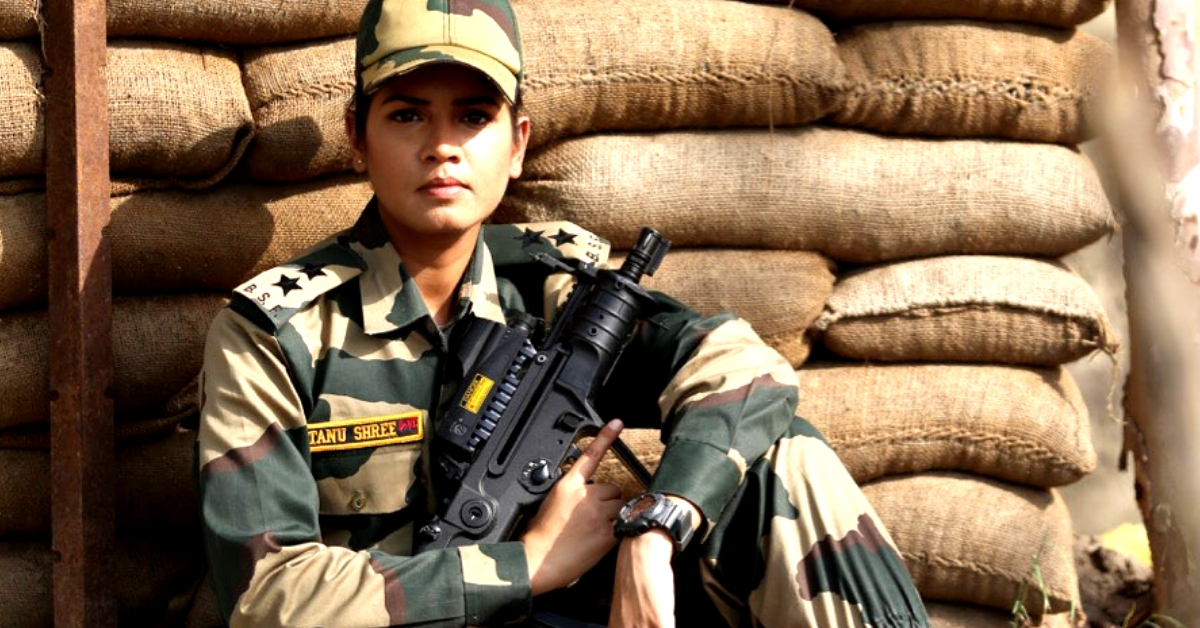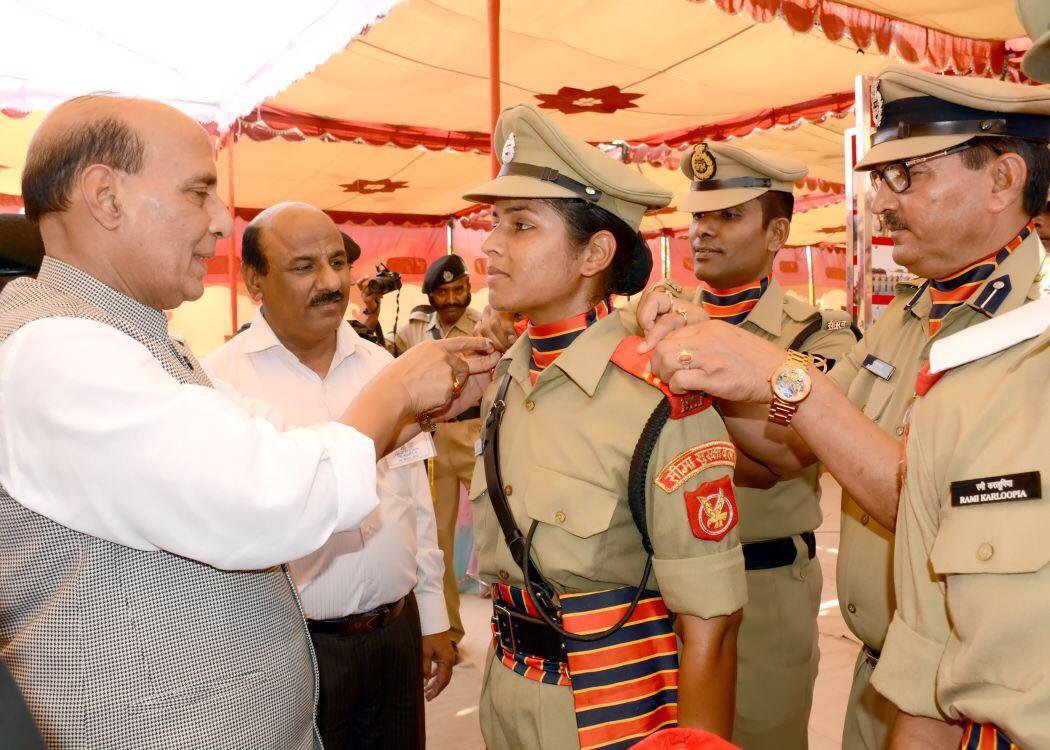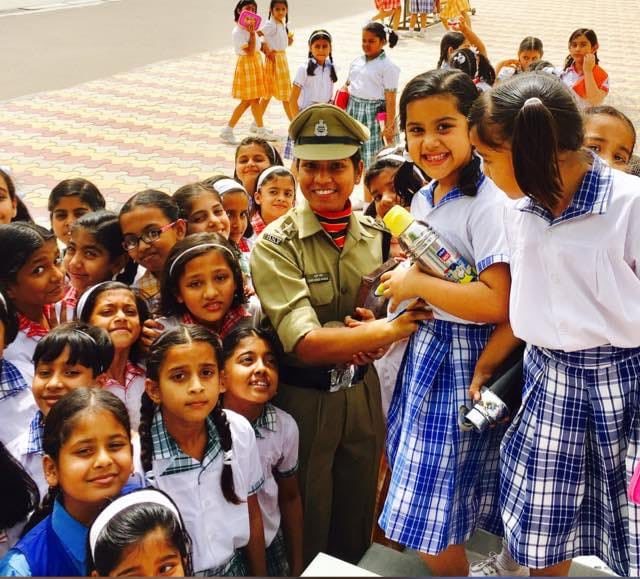Exclusive: Meet Tanu Shree Pareek, BSF’s First Woman Combat Officer In 51 Years
It was a moment of pride as she led the Raising Day Parade of the 67 trainee officers at the BSF Academy in Gwalior, the only woman among 66 male officers.

In 2016, Bikaner girl Tanu Shree Pareek created history by becoming the first woman combat officer in the Border Security Forces’ 51-year existence. Only three years prior, in 2013, had the border sentinel allowed women to apply for the rank of officers for the first time.
It was a moment of pride as she led the Raising Day Parade of the 67 trainee officers at the BSF Academy in Gwalior, the only woman among 66 male officers.

Her family couldn’t have been prouder as Union Home Minister Rajnath Singh put the rank stars on their daughter’s shoulders during the piping ceremony.
Sweeping her way through the four-phased arduous recruitment process, Tanu Shree became the first woman assistant commandant in the 2.5 lakh force.
This is the story of unmatched hard work that this trailblazer put in to open the gates of new opportunities for women.
Born and raised in the small city of Bikaner, she completed her B.Tech in electronics and communications from the Government Engineering College.
Whether it was during her school or college, the young girl had always been adept in extra-curricular activities. A state U-17 badminton champion, and a horse-rider, she was also a part of the National Cadet Corps. It was how the fascination of donning a uniform and the spirit to serve the country began.
In the seven generations of her family, she is the first to join the paramilitary forces. She was 22 and had only completed her engineering when she wrote the UPSC CAPF exam. Even her parents weren’t privy to the details until she told them that she had qualified.
During this time, she was placed in the leading MNC, IBM. But deep down she knew that working with machines was not her calling.
So, she chose the forces instead.
Her father, Dr S P Joshi, a veterinarian and Professor of Parasitology at the Veterinary University of Bikaner, had always been a practical man and Tanu Shree’s constant pillar of support.

While he believed she could achieve anything she set her heart to, he was honest enough to point her lack of physical fitness at the time.
If she had to clear the physical test, she would have to shed the extra kilos. When most people would hit the gym, Tanu Shree decided to embark on her fitness journey on her own.
Rigorous running laps, a strict GM diet and lots of physical activity helped her lose over seven kgs in a month!
“In the 26 years of my life, I have never been to a gym, even for a day,” she laughs.
It wasn’t until the BSF came out with its list that she knew she was the first woman officer to begin training at its academy in 2016.
In a campus with over 16,000 men, including batchmates, staff and instructing officers, the only women she saw were the wives of officers. It made her realise the responsibility of her journey.
Being the only woman, she knew she had to work twice as hard as her male counterparts because she was going to set the bar. From her trainers though, she did not receive any special attention and was another trainee officer–number 13.
52 weeks of training bore fruit, when she stood second in her batch and was bestowed three awards for her outstanding achievements in the drill, as the all-round best trainee, and for public speaking.
Was this easy? Certainly not!
Over 20 trainees had dropped out, but not Tanu Shree. This did not mean that she didn’t have bad days.
“My body was worn out, my sleep schedule disrupted, my skin and hair were showing the repercussions of the training. What really broke me down was the paycheck that arrived after two months of training. I cried as it was half the salary I got during my IBM stint. I called my father, ‘I roam and jump like a monkey all day. There is no comfort, let alone luxury. Why am I putting myself through all of this?’ I cried,” she recalls.
Her father simply told her to set an example for women by doing what no woman had done so far.
“But how could I give up?” she continues. “I had always stood for gender equality, not additional provisions or privileges. I knew that if I quit, everyone who was closely monitoring me would think, ‘The first woman officer came, but couldn’t even survive the test.’ If I quit, people wouldn’t say ‘Tanu Shree failed’, they would say ‘women are not cut out for the BSF’.”
Tanu Shree decided that she wouldn’t let anyone question the entire women fraternity, and so, she pushed herself through the training.
She states, “I did it. Not for myself, not for my family, but for every woman and girl who dared to dream to be a part of the force.”
But Tanu Shree preferred the BSF or any other paramilitary force over the tri-forces. She explains, “I did not want to be a part of a force that was skewed against women. BSF appealed to me because it is egalitarian in its approach. Where personnel in each of their respective ranks–from constables to officers, men or women–have the same benefits and salaries.”
READ MORE: Meet India’s First Woman Firefighter, a Trailblazer for Generations of Women to Come!
Tanu Shree Pareek is currently posted in the hotspot of drug addiction along the Punjab border. Although the government is making efforts to curb the drug problem, there’s a long way to go, she shares.

“It is heartbreaking to see not just men but also women and young kids addicted to substances and abuse them. Much of this drug peddling and smuggling happens across the Punjab-Pakistan border. Our force is guarding it 24×7 to stop it,” she adds.
Unlike the other armed forces who have peacetime postings, there is no war or peacetime for the BSF. They are deployed on the frontlines that are prone to infiltration. Whether Kashmir, Gujarat, the Sundarbans or Punjab, each of these borders has unique problems.
“We work for long hauls, with no Saturdays, Sundays or festivals. In the same way, when we get our 60 earned leaves, every day is counted, which includes the weekends and public holidays,” she says.
When asked if she ever fears for her life on the border, she smiles, “It would be the most respectful death, if I were to lose my life on duty.”
As the ambassador of Beti Padhao, Beti Bachao, she is more occupied on her leave days than at her posting. She travels across schools and colleges to interact with young individuals.
On one such expedition with the Indian Air Force, a 50-day camel safari, she traversed the border states of Rajasthan, Gujarat and Punjab, visiting over 100 government schools.

“When I met the girls, I realised that many of them did not even have the courage to stand and recite a poem. This showed me the inequality in their own homes, where girls couldn’t even speak in front of their male counterparts. This is where the difference between India and Bharat lies,” says the officer who has completed her masters in rural development and is currently pursuing gender studies.
In the 2000s women personnel on the border was unheard of. But this changed after the appointment of Assistant Commandant Tanu Shree Pareek. Today, the 2.5 lakh force of the BSF has 50,000 women.
But the number is still low when compared to the overall strength of the BSF, maintains Tanu Shree. “The government is working towards it. But people need to change their mindsets too. Why is a woman considered adept at clerical and administrative jobs in the force? We have to treat them as equally capable of frontline operations too!” she insists.
Infrastructure is also a major concern for women serving on the borders, as well as in other Central Armed Police Forces.
In a few locations, rehabilitation from the border is 200 kms away. Besides, hygiene and sanitation are also vital factors.
“There are no toilets. It isn’t a necessity for women alone, but men too. If these infrastructural gaps are filled, the number will steadily rise,” she states.
As the first woman who laid the foundation for others of her sex to join the forces, Tanu Shree Pareek has come a long way.
How did she get here?
By believing in the power of her dreams and fuelling them with hard work.
“To parents, I would like to say, don’t treat your children separately as boys or girls. Raise them as equals. A vote of confidence and an assurance that you believe in their dreams can help them go places,” she signs off.
(Edited by Shruti Singhal)
If this story inspired you get in touch with Tanu Shree Pareek at [email protected]
Like this story? Or have something to share?
Write to us: [email protected]
Connect with us on Facebook and Twitter.
If you found our stories insightful, informative, or even just enjoyable, we invite you to consider making a voluntary payment to support the work we do at The Better India. Your contribution helps us continue producing quality content that educates, inspires, and drives positive change.
Choose one of the payment options below for your contribution-
By paying for the stories you value, you directly contribute to sustaining our efforts focused on making a difference in the world. Together, let’s ensure that impactful stories continue to be told and shared, enriching lives and communities alike.
Thank you for your support. Here are some frequently asked questions you might find helpful to know why you are contributing?


This story made me
-
97
-
121
-
89
-
167













